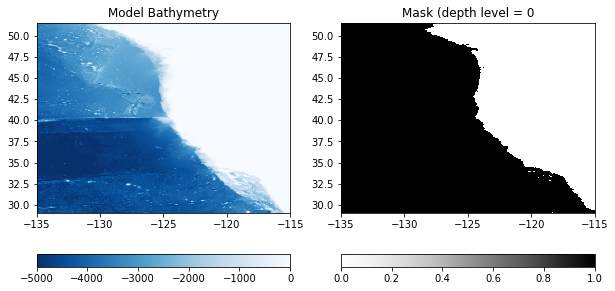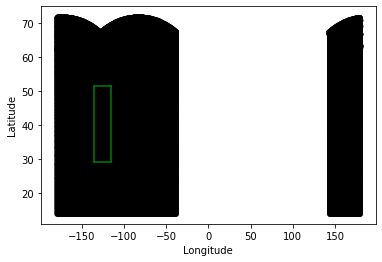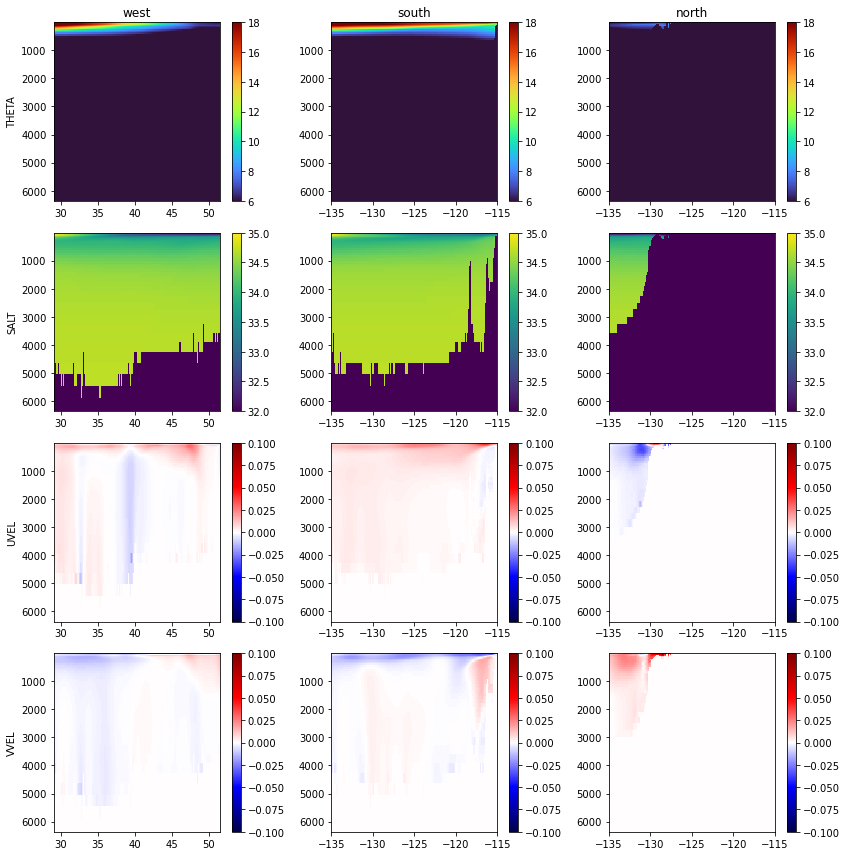Boundary Conditions#
This notebook serves as a demo for the creation of model boundary conditions for the Calfornia regional model.
First, import packages to re-create and visualize the model fields here:
import os
import numpy as np
import matplotlib.pyplot as plt
from matplotlib.gridspec import GridSpec
import netCDF4 as nc4
Next, define the location of the input directory for the model. This is the same directory that holds the bathymetry file generated in the previous notebooks for this model example.
# define the input directory
input_dir = '../data/input'
Constructing the Boundary Conditions#
For my model, I will use a model state from the ECCO Version 5 state estimate. I will prepare the boundary condition fields in 7 steps:
download 5 fields and 4 grid files generated by the ECCO model in 2008
read the ECCO model grid
read in the bathymetry for my model as well as its grid
prepare the ECCO fields for interpolation
interpolate the ECCO fields onto my model grid and store each as a binary file
plot the interpolated fields to ensure they look as expected
prepare notes on the run-time options I will use to implement my approach
Step 1: Download the ECCO fields#
To begin, I downloaded the model fields generated by the ECCO Version 5 Alpha state estimate. These fields are available HERE. In particular, I downloaded the following list of files that contain the fields pertaining to time span of my model (2008):
Variable |
File Name |
|---|---|
THETA |
THETA/THETA_2008.nc |
SALT |
SALT/SALT_2008.nc |
UVEL |
UVELMASS/UVELMASS_2008.nc |
VVEL |
VVELMASS/VVELMASS_2008.nc |
Note that these are the same files used to generate the initial conditions. I stored these fields in the following directory:
data_folder = '../data/ECCO'
Step 2: Read in the ECCO grid#
To read in the ECCO fields, I will rely on the grid module from the eccoseas.ecco package HERE, which I import here:
from eccoseas.ecco import grid
ecco_XC_tiles = grid.read_ecco_grid_tiles_from_nc(data_folder, var_name='XC')
ecco_YC_tiles = grid.read_ecco_grid_tiles_from_nc(data_folder, var_name='YC')
ecco_hFacC_tiles = grid.read_ecco_grid_tiles_from_nc(data_folder, var_name='hFacC')
ecco_hFacW_tiles = grid.read_ecco_grid_tiles_from_nc(data_folder, var_name='hFacW')
ecco_hFacS_tiles = grid.read_ecco_grid_tiles_from_nc(data_folder, var_name='hFacS')
ecco_RF_tiles = grid.read_ecco_grid_tiles_from_nc(data_folder, var_name='RF')
As described HERE, the ECCO grid has 13 tiles but only 1 or 2 may pertain to my local area. To determine which tiles correspond to my region, I’ll read in my model grid next.
Step 3: Read in the Model Grid and Generate a Mask#
Here, I will recreate the grid I will use in my model and read in the bathymetry file (see previous notebooks for details):
# define the parameters that will be used in the data file
delX = 1/12
delY = 1/16
xgOrigin = -135
ygOrigin = 29
n_rows = 360
n_cols = 240
# recreate the grids that will be used in the model
xc = np.arange(xgOrigin+delX/2, xgOrigin+n_cols*delX, delX)
yc = np.arange(ygOrigin+delY/2, ygOrigin+n_rows*delY+delY/2, delY)
XC, YC = np.meshgrid(xc, yc)
# read in the bathymetry file
bathy = np.fromfile(os.path.join(input_dir,'CA_bathymetry.bin'),'>f4').reshape(np.shape(XC))
With an eye toward the interpolation to come next, I will make a mask to determine where the interpolatation will take place. I will create this mask by recreating the hFac field for my model using the hFac module from the eccoseas package:
from eccoseas.downscale import hFac
depth = bathy
delR = np.array([ 10.00, 10.00, 10.00, 10.00, 10.00, 10.00, 10.00, 10.01,
10.03, 10.11, 10.32, 10.80, 11.76, 13.42, 16.04, 19.82, 24.85,
31.10, 38.42, 46.50, 55.00, 63.50, 71.58, 78.90, 85.15, 90.18,
93.96, 96.58, 98.25, 99.25,100.01,101.33,104.56,111.33,122.83,
139.09,158.94,180.83,203.55,226.50,249.50,272.50,295.50,318.50,
341.50,364.50,387.50,410.50,433.50,456.50,])
Z = np.cumsum(delR)
hFacC = hFac.create_hFacC_grid(depth, delR)
The mask is generated by setting all of the non-zero hFac points to 1:
mask = np.copy(hFacC)
mask[mask>0] = 1
To double check the mask was created as expected, I will plot it in comparison to the bathymetry here:
plt.figure(figsize=(10,5))
plt.subplot(1,2,1)
C = plt.pcolormesh(XC, YC, bathy, vmin=-5000, vmax=0, cmap='Blues_r')
plt.colorbar(C, orientation = 'horizontal')
plt.title('Model Bathymetry')
depth_level = 0
plt.subplot(1,2,2)
C = plt.pcolormesh(XC, YC, mask[0], vmin=0, vmax=1, cmap='Greys')
plt.colorbar(C, orientation = 'horizontal')
plt.title('Mask (depth level = '+str(depth_level))
plt.show()

Seems reasonable!
Step 4: Prepare the grids for interpolation#
At this point, we can use the geometry of both grids to check to see which tiles have the information we need. After some trial and error (and referencing the ECCO page), I find that tiles 8 and 11 have the points I need:
# plot the ECCO tile points from tiles 8 and 11
plt.plot(ecco_XC_tiles[11],ecco_YC_tiles[11],'k.')
plt.plot(ecco_XC_tiles[8],ecco_YC_tiles[8],'k.')
# plot the boundary of the CA model
plt.plot(XC[:,0],YC[:,0], 'g-')
plt.plot(XC[:,-1],YC[:,-1], 'g-')
plt.plot(XC[0,:],YC[0,:], 'g-')
plt.plot(XC[-1,:],YC[-1,:], 'g-')
plt.xlabel('Longitude')
plt.ylabel('Latitude')
plt.show()

As we can see, my model boundary (green) is completely surrounded by the points in tile 8 and 11 (black). I also note that there is extraneous information in points with longitude greater than ~140 - I will omit these points as well. Given these observations, now I read in points from just those tiles to use in interpolation:
tile_list = [8,11]
# determine the number of points in each set
total_points = 0
for tile_number in tile_list:
total_points += np.size(ecco_XC_tiles[tile_number])
# make empty arrays to fill in
ecco_XC_points = np.zeros((total_points, ))
ecco_YC_points = np.zeros((total_points, ))
ecco_hFacC_points = np.zeros((np.size(ecco_RF_tiles[1]) , total_points))
ecco_hFacW_points = np.zeros((np.size(ecco_RF_tiles[1]) , total_points))
ecco_hFacS_points = np.zeros((np.size(ecco_RF_tiles[1]) , total_points))
ecco_mask_points = np.zeros((np.size(ecco_RF_tiles[1]) , total_points))
# loop through the tiles and fill in the XC, YC, and mask points for interpolation
points_counted = 0
for tile_number in tile_list:
tile_N = np.size(ecco_XC_tiles[tile_number])
ecco_XC_points[points_counted:points_counted+tile_N] = ecco_XC_tiles[tile_number].ravel()
ecco_YC_points[points_counted:points_counted+tile_N] = ecco_YC_tiles[tile_number].ravel()
for k in range(np.size(ecco_RF_tiles[tile_number])):
level_hFacC = ecco_hFacC_tiles[tile_number][k, :, :]
level_hFacW = ecco_hFacW_tiles[tile_number][k, :, :]
level_hFacS = ecco_hFacS_tiles[tile_number][k, :, :]
level_mask = np.copy(level_hFacC)
level_mask[level_mask>0] = 1
ecco_hFacC_points[k, points_counted:points_counted+tile_N] = level_hFacC.ravel()
ecco_hFacW_points[k, points_counted:points_counted+tile_N] = level_hFacW.ravel()
ecco_hFacS_points[k, points_counted:points_counted+tile_N] = level_hFacS.ravel()
ecco_mask_points[k,points_counted:points_counted+tile_N] = level_mask.ravel()
points_counted += tile_N
# remove the points with positive longitude
local_indices = ecco_XC_points<0
ecco_mask_points = ecco_mask_points[:, local_indices]
ecco_hFacC_points = ecco_hFacC_points[:, local_indices]
ecco_hFacW_points = ecco_hFacW_points[:, local_indices]
ecco_hFacS_points = ecco_hFacS_points[:, local_indices]
ecco_YC_points = ecco_YC_points[local_indices]
ecco_XC_points = ecco_XC_points[local_indices]
Next, we’ll read in the real data fields and apply the modifications. First, create a dictionary to store the file names:
# make a file dictionary to loop over
year = 2008
file_prefix_dict = {'THETA':'THETA_'+str(year)+'.nc',
'SALT':'SALT_'+str(year)+'.nc',
'UVEL':'UVELMASS_'+str(year)+'.nc',
'VVEL':'VVELMASS_'+str(year)+'.nc'}
variable_names = list(file_prefix_dict.keys())
Now, read the fields from the same tiles:
# make a list to hold all of the ECCO grids
init_grids = []
timesteps = 12 # data is monthly
# loop through each variable to read in the grid
for variable_name in variable_names:
if variable_name == 'ETAN':
ds = nc4.Dataset(os.path.join(data_folder,file_prefix_dict[variable_name]))
grid = ds.variables[variable_name][:,:,:,:]
ds.close()
elif 'VEL' in variable_name:
ds = nc4.Dataset(os.path.join(data_folder,'UVELMASS_'+str(year)+'.nc'))
u_grid = ds.variables['UVELMASS'][:,:,:,:,:]
ds.close()
ds = nc4.Dataset(os.path.join(data_folder,'VVELMASS_'+str(year)+'.nc'))
v_grid = ds.variables['VVELMASS'][:,:,:,:,:]
ds.close()
else:
ds = nc4.Dataset(os.path.join(data_folder,file_prefix_dict[variable_name]))
grid = ds.variables[variable_name][:,:,:,:,:]
ds.close()
# create a grid of zeros to fill in
N = np.shape(grid)[-1]*np.shape(grid)[-2]
if variable_name == 'ETAN':
init_grid = np.zeros((timesteps, 1, N*len(tile_list)))
else:
init_grid = np.zeros((timesteps, np.size(ecco_RF_tiles[1]), N*len(tile_list)))
# loop through the tiles
for t in range(timesteps):
points_counted = 0
for tile_number in tile_list:
if variable_name == 'ETAN':
init_grid[t, points_counted:points_counted+N] = \
grid[t, tile_number-1, :, :].ravel()
elif 'VEL' in variable_name: # when using velocity, need to consider the tile rotations
if variable_name == 'UVEL':
if tile_number<7:
for k in range(np.size(ecco_RF_tiles[1])):
init_grid[t, k,points_counted:points_counted+N] = \
u_grid[t, k, tile_number-1, :, :].ravel()
else:
for k in range(np.size(ecco_RF_tiles[1])):
init_grid[t, k,points_counted:points_counted+N] = \
v_grid[t, k, tile_number-1, :, :].ravel()
if variable_name == 'VVEL':
if tile_number<7:
for k in range(np.size(ecco_RF_tiles[1])):
init_grid[t,k,points_counted:points_counted+N] = \
v_grid[t, k, tile_number-1, :, :].ravel()
else:
for k in range(np.size(ecco_RF_tiles[1])):
init_grid[t,k,points_counted:points_counted+N] = \
-1*u_grid[t, k, tile_number-1, :, :].ravel()
else:
for k in range(np.size(ecco_RF_tiles[1])):
init_grid[t,k,points_counted:points_counted+N] = \
grid[t, k, tile_number-1, :, :].ravel()
points_counted += N
# remove the points with positive longitudes
init_grid = init_grid[:,:,local_indices]
# apply some corrections
if variable_name == 'UVEL':
for t in range(timesteps):
for k in range(np.size(ecco_RF_tiles[1])):
non_zero_indices = ecco_hFacW_points[k,:]!=0
init_grid[t,k,non_zero_indices] = init_grid[t,k,non_zero_indices]/(ecco_hFacW_points[k,non_zero_indices])
if variable_name == 'VVEL':
for t in range(timesteps):
for k in range(np.size(ecco_RF_tiles[1])):
non_zero_indices = ecco_hFacS_points[k,:]!=0
init_grid[t,k,non_zero_indices] = init_grid[t,k,non_zero_indices]/(ecco_hFacS_points[k,non_zero_indices])
init_grids.append(init_grid)
Step 5: Interpolate the Fields onto the Model Grid#
Next, I will interpolate the ECCO external fields I read in onto my model domain. I will use the horizonal module from the eccoseas package to accomplish this interpolation.
from eccoseas.downscale import horizontal
# define the boundary list for the model
boundary_list = ['west','south','north']
if 'obcs' not in os.listdir(input_dir):
os.mkdir(os.path.join(input_dir,'obcs'))
# define the number of timesteps
timesteps = 1
# timesteps = 12 # data is monthly, uncomment after testing
# loop through each boundary
for boundary in boundary_list:
print(' - Working on the '+boundary+' boundary')
if boundary == 'west':
boundary_XC = XC[:,:1]
boundary_YC = YC[:,:1]
boundary_mask = mask[:,:,:1]
elif boundary == 'east':
boundary_XC = XC[:,-1:]
boundary_YC = YC[:,-1:]
boundary_mask = mask[:,:,-1:]
elif boundary == 'north':
boundary_XC = XC[-1:,:]
boundary_YC = YC[-1:,:]
boundary_mask = mask[:,-1:,:]
elif boundary == 'south':
boundary_XC = XC[:1,:]
boundary_YC = YC[:1,:]
boundary_mask = mask[:,:1,:]
else:
raise ValueError('Boundary '+boundary+' not recognized')
# loop through each variable and corresponding ECCO grid
for variable_name, init_grid in zip(variable_names, init_grids):
output_grid = np.zeros((timesteps, np.size(delR), np.size(boundary_XC)))
# print a message to keep track of which variable we are working on
print(' - Interpolating the '+variable_name+' grid')
for t in range(timesteps):
interpolated_grid = horizontal.downscale_3D_points(np.column_stack([ecco_XC_points, ecco_YC_points]),
init_grid[t,:,:], ecco_mask_points,
boundary_XC, boundary_YC, boundary_mask)
for k in range(len(delR)):
output_grid[t,k,:] = interpolated_grid[k,:,:].ravel()
# output the interpolated grid
output_file = os.path.join(input_dir,'obcs',variable_name+'_'+boundary+'_'+str(year))
output_grid.ravel('C').astype('>f4').tofile(output_file)
- Interpolating the THETA grid
- Interpolating the SALT grid
- Interpolating the UVEL grid
- Interpolating the VVEL grid
- Interpolating the THETA grid
- Interpolating the SALT grid
- Interpolating the UVEL grid
- Interpolating the VVEL grid
- Interpolating the THETA grid
- Interpolating the SALT grid
- Interpolating the UVEL grid
- Interpolating the VVEL grid
Step 6: Plotting the Boundary Fields#
Now that the fields have been generated, I will plot them to ensure they look as expected. First, I’ll generate some metadata for each one:
meta_dict = {'THETA':[6, 18, 'turbo', 'm'],
'SALT':[32, 35, 'viridis', 'm'],
'UVEL':[-0.1, 0.1, 'seismic', 'm'],
'VVEL':[-0.1, 0.1, 'seismic', 'm']}
Then, I’ll create all of the subplots:
fig = plt.figure(figsize=(12,12))
plot_counter = 0
for i in range(len(variable_names)):
variable_name = variable_names[i]
for boundary in boundary_list:
boundary_grid = np.fromfile(os.path.join(input_dir,'obcs',variable_name+'_'+boundary+'_2008'),'>f4')
if boundary in ['west','east']:
boundary_grid = boundary_grid.reshape((timesteps, np.shape(delR)[0],np.shape(XC)[0]))
boundary_grid = boundary_grid[0, :, :] # choose just the first timestep for plotting
if boundary=='west':
x = YC[:,1]
if boundary=='east':
x = YC[:,-1]
else:
boundary_grid = boundary_grid.reshape((timesteps, np.shape(delR)[0],np.shape(XC)[1]))
boundary_grid = boundary_grid[0, :, :] # choose just the first timestep for plotting
if boundary=='north':
x = XC[-1,:]
if boundary=='south':
x = XC[1,:]
plot_counter += 1
plt.subplot(len(variable_names),len(boundary_list),plot_counter)
C = plt.pcolormesh(x, Z, boundary_grid,
vmin=meta_dict[variable_names[i]][0],
vmax=meta_dict[variable_names[i]][1],
cmap=meta_dict[variable_names[i]][2])
plt.colorbar(C,fraction=0.26)
plt.gca().invert_yaxis()
if plot_counter%3==1:
plt.ylabel(variable_name)
if plot_counter<4:
plt.title(boundary)
plt.tight_layout()
plt.show()

Looks good! Now, with the initial conditions, external forcing conditions, and boundary conditions we are nearly ready to start testing the model!
Step 7: Run-time considerations#
To use the grids as boundary conditions in the model, I will use the obcs package - short for Open Boundary Condtions. To ensure the boundary conditions are included in the model, I will add a line for obcs in my code/packages.conf compile time file.
Next, I will add a line with useOBCS=.TRUE. to the data.pkg file and a new file called data.obcs to my run directory. See Canvas for an editable data.obcs file.
